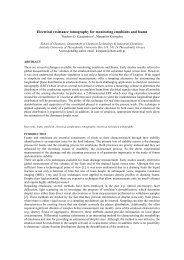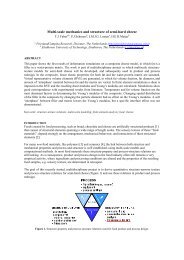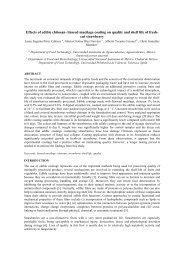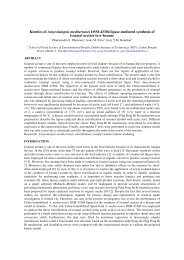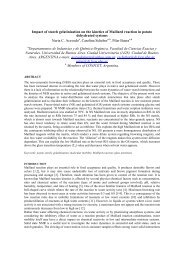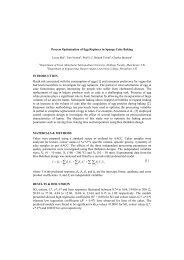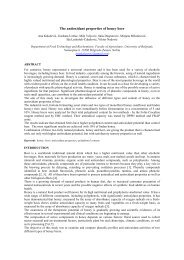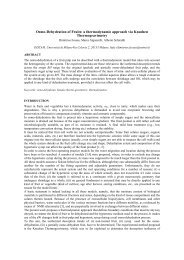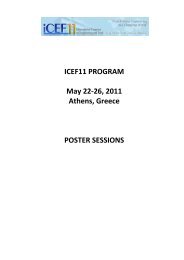Instructions to authors - 11th International Congress on Engineering ...
Instructions to authors - 11th International Congress on Engineering ...
Instructions to authors - 11th International Congress on Engineering ...
You also want an ePaper? Increase the reach of your titles
YUMPU automatically turns print PDFs into web optimized ePapers that Google loves.
soluti<strong>on</strong>s, the high water c<strong>on</strong>sumpti<strong>on</strong> and the losses of nutriti<strong>on</strong>al soluble compounds in the osmotic<br />
soluti<strong>on</strong>.<br />
The dry osmotic dehydrati<strong>on</strong> might be an opti<strong>on</strong> <str<strong>on</strong>g>to</str<strong>on</strong>g> elaborate this kind of products as the volume of soluti<strong>on</strong><br />
generated is c<strong>on</strong>siderably lower than the volume managed in the wet method and it is more c<strong>on</strong>centrated in<br />
aromatic compounds, soluble vitamins and minerals as it comes from the product itself.<br />
The aim of this work was <str<strong>on</strong>g>to</str<strong>on</strong>g> analyze and compare the physicochemical aspects of an isomaltulose kiwi<br />
spread fruit made by means of dry osmotic dehydrati<strong>on</strong>.<br />
MATERIALS & METHODS<br />
Kiwis (Actinidia deliciosa), acquired in a local supermarket were handy selected <str<strong>on</strong>g>to</str<strong>on</strong>g> avoid physical damage.<br />
Samples were peeled, cut in 1 cm 3 cubes and sink in chloride water.<br />
Equilibrium stage: two different osmotic dehydrati<strong>on</strong> methods were used, Wet Osmotic Dehydrati<strong>on</strong><br />
(WOD), in which the fruit was immersed in a hyper<str<strong>on</strong>g>to</str<strong>on</strong>g>nic osmotic soluti<strong>on</strong> (40 Brix) and Dry Osmotic<br />
Dehydrati<strong>on</strong> (DOD), in which the osmotic agent was placed directly <strong>on</strong> the fruit like in meat or fish salting<br />
process. The equilibrium c<strong>on</strong>centrati<strong>on</strong> achieved in this stage was 30 Brix. The ratio fruit:sugar or<br />
fruit:soluti<strong>on</strong> was calculated by mass balances. Sucrose or Isomaltulose were used as osmotic agents. The<br />
work temperature was 25 ºC.<br />
Product formulati<strong>on</strong>: the ingredients in the spread formulati<strong>on</strong>s were dehydrated kiwi, osmotic soluti<strong>on</strong>,<br />
apple pectin (1, 1.5, 2 %) as a jelling agent and potassium sorbate (500 ppm) as a preservative. The different<br />
obtained kiwi spread products obtained can be seen <strong>on</strong> table 1. According <str<strong>on</strong>g>to</str<strong>on</strong>g> the different proporti<strong>on</strong>s of<br />
dehydrated kiwi:osmotic soluti<strong>on</strong> and depending <strong>on</strong> the dehydrati<strong>on</strong> methods, three kinds of process were<br />
selected.<br />
• WOD: 70 % dehydrated fruit and 30 % osmotic final soluti<strong>on</strong>.<br />
• DOD1: 100 % dehydrated fruit and 100 % generated osmotic soluti<strong>on</strong><br />
• DOD2: 70 % dehydrated fruit and 30 % generated osmotic soluti<strong>on</strong>.<br />
Table 1. Experimental design of the different kiwi spread products.<br />
Dehydrati<strong>on</strong><br />
Dehydrati<strong>on</strong><br />
Pectin %<br />
kind<br />
kind<br />
Pectin %<br />
SUCROSE<br />
ISOMALTULOSE<br />
1 1 10 1<br />
2 WOD 1.5 11 WOD 1.5<br />
3 2 12 2<br />
4 1 13 1<br />
5 DOD 1.5 14 DOD 1.5<br />
6 2 15 2<br />
7 1 16 1<br />
8 DOD 1.5 17 DOD 1.5<br />
9 2 18 2<br />
Physicochemical analysis: Measurements were carried out by triplicate. Moisture c<strong>on</strong>tent was determined<br />
gravimetrically by drying <str<strong>on</strong>g>to</str<strong>on</strong>g> c<strong>on</strong>stant weight in a vacuum oven at 60 ºC (method 20.103 AOAC, 1980).<br />
Soluble solids c<strong>on</strong>tent (Brix) was measured in samples, previously homogenized, with a refrac<str<strong>on</strong>g>to</str<strong>on</strong>g>meter at 20<br />
ºC (ATAGO 3 T). Water activity (a w ) was determined with a dew point hygrometer (FA-st lab, GBX). pH<br />
was determined by a pH-meter (SevenEasy, Mettler Toledo).<br />
Colour measurements: Instrumental measurements of colour were c<strong>on</strong>ducted at room temperature in a<br />
Minolta spectropho<str<strong>on</strong>g>to</str<strong>on</strong>g>meter (model CM-3600d) by placing the kiwi spread in a 20 mm thick and transparent<br />
plastic cell and by using a black plate as the background <str<strong>on</strong>g>to</str<strong>on</strong>g> standardize the measurements. Visible absorpti<strong>on</strong>
spectrum was recorded between 380 and 770 nm by reflectance <str<strong>on</strong>g>to</str<strong>on</strong>g> obtain tristimulus values of CIEL*a*b*,<br />
using illuminant D 65 and standard observer (10° visual field) as references.<br />
Texture determinati<strong>on</strong>s: Objective determinati<strong>on</strong>s of strength and c<strong>on</strong>sistence were under the back-extrusi<strong>on</strong><br />
test using a texturometer TA/XT/PLUS Texture Analyzer and the accessory Back extrusi<strong>on</strong> cell with 35 cm<br />
ring [1, 2].<br />
The back-extrusi<strong>on</strong> test c<strong>on</strong>sisted <strong>on</strong> making a circular base embolus of 35 mm of diameter, go through the<br />
sample c<strong>on</strong>tained in a glass cylindrical vessel, at a c<strong>on</strong>stant speed of 1 mm·s -1 . For all the assays the embolus<br />
covered the same distance until the bot<str<strong>on</strong>g>to</str<strong>on</strong>g>m of the vessel and the amount of sample was the same.<br />
RESULTS & DISCUSSION<br />
After the formulati<strong>on</strong> of the different kiwi spreads they were s<str<strong>on</strong>g>to</str<strong>on</strong>g>rage during 24 hours at room temperature <str<strong>on</strong>g>to</str<strong>on</strong>g><br />
allow the gel formati<strong>on</strong>. Then analysis of moisture (x w ), soluble solids c<strong>on</strong>tent (x ss ), and water activity (a w ),<br />
pH as well as colour and texture determinati<strong>on</strong> were performed.<br />
The obtained products showed a similar compositi<strong>on</strong> in terms of moisture and soluble solids c<strong>on</strong>tent which<br />
could be expected as the ratio was calculated <str<strong>on</strong>g>to</str<strong>on</strong>g> reach a final c<strong>on</strong>centrati<strong>on</strong> of 30 Brix. The solid soluble<br />
c<strong>on</strong>tent of the final spread-products was 0.291 (± 0.03) and the moisture of 0.69 (± 0.02). On the other hand,<br />
a w showed values of 0.964 (± 0.006). Finally the final pH value for the formulated products was around 3.37<br />
(± 0.07). Therefore no differences depending <strong>on</strong> the different sugars, dehydrati<strong>on</strong> methods or pectin<br />
percentages were found in terms of physicochemical parameters <strong>on</strong> the final products. These results are<br />
c<strong>on</strong>trary <str<strong>on</strong>g>to</str<strong>on</strong>g> those obtained for the same kind of spreads elaborated with strawberry where the isomaltulose<br />
spreads showed a higher a w compared with the sucrose <strong>on</strong>es [3].<br />
Colour analysis: Figure 1 shows the colorimetric coordinates (L*, a*, b*) of the different kiwi spread as well<br />
as the coordinates of fresh kiwi.<br />
1.5 % Pectin<br />
1.5 % Pectin<br />
FRESH<br />
Figure 1. Colour coordinates of the samples in the chromatic planes b*-a* and L*-a*.
As can be seen <strong>on</strong> Figure 1, all the samples were very similar <str<strong>on</strong>g>to</str<strong>on</strong>g> the fresh <strong>on</strong>e and there was not a clear<br />
tendency in the colour coordinates (L*, a*, b*) of samples depending <strong>on</strong> osmotic dehydrati<strong>on</strong> method, kind<br />
of osmotic agent or pectin percentage; similar results have been reported in <str<strong>on</strong>g>to</str<strong>on</strong>g>ma<str<strong>on</strong>g>to</str<strong>on</strong>g> spreads of 50 Brix [4],<br />
while colour differences have been notice in other spread-products such as in strawberry <strong>on</strong>es depending of<br />
osmotic agent [3]. This fact could be related <str<strong>on</strong>g>to</str<strong>on</strong>g> the high stability of kiwi pigments and lower degree of<br />
interacti<strong>on</strong> within the system comp<strong>on</strong>ents compared <str<strong>on</strong>g>to</str<strong>on</strong>g> those present in strawberries.<br />
Texture analysis: Figure 2 shows the c<strong>on</strong>sistency and cohesiveness of the different samples obtained after<br />
back extrusi<strong>on</strong> test. It can be seen that no differences in texture parameters were found between the different<br />
products as a c<strong>on</strong>sequence of the different sugars used in their formulati<strong>on</strong>s. On the other hand, spreadproducts<br />
with different c<strong>on</strong>sistency and cohesiveness characteristics could be obtained depending <strong>on</strong> osmotic<br />
dehydrati<strong>on</strong> method and pectin percentage used.<br />
WOD DOD1 DOD2 WOD DOD1 DOD2<br />
WOD DOD1 DOD2<br />
Figure 2. C<strong>on</strong>sistency and cohesiveness of the different samples obtained after back extrusi<strong>on</strong> test.<br />
CONCLUSION<br />
This work c<strong>on</strong>firmed the viability of DOD and the use of new sugars (ex, Isomaltulose) as an alternative <str<strong>on</strong>g>to</str<strong>on</strong>g><br />
obtain <str<strong>on</strong>g>to</str<strong>on</strong>g>ma<str<strong>on</strong>g>to</str<strong>on</strong>g> spreads with colour and texture comparable <str<strong>on</strong>g>to</str<strong>on</strong>g> those elaborated by WOD with sucrose. The<br />
final product obtained by DOD is additi<strong>on</strong>ally richer in aromatic compounds, soluble vitamins and minerals<br />
from fresh fruit since effluents are not generated, getting <str<strong>on</strong>g>to</str<strong>on</strong>g> increase the process yield. Furthermore, as<br />
isomaltulose has less sweetener power than sucrose, the obtained product is closer in taste <str<strong>on</strong>g>to</str<strong>on</strong>g> fresh fruit than<br />
the product processed with sucrose.<br />
REFERENCES<br />
[1] Garcia-Martinez, E., Ruiz-Diaz, J., Martinez-M<strong>on</strong>zó, J., Camacho, M.M., Martinez-Navarrete, N. & Chiralt, A.<br />
2002. Jam manufacture with osmodehydrated fruit. Food Research <str<strong>on</strong>g>Internati<strong>on</strong>al</str<strong>on</strong>g> 35: 301-306.<br />
[2] Sesmero. R, Quesada, M. A. & Mercado J. A. 2007. Antisense inhibiti<strong>on</strong> of pectate lyase gene<br />
expressi<strong>on</strong> in strawberry fruit: Characteristics of fruits processed in<str<strong>on</strong>g>to</str<strong>on</strong>g> jam. Journal of Food <strong>Engineering</strong><br />
79(1): 194-199.<br />
[3] Peinado, I., Rosa, E., Heredia, A. & Andrés, A. 2008. Estudio comparativo del color en fresa deshidratada<br />
osmóticamente c<strong>on</strong> sacarosa, sorbi<str<strong>on</strong>g>to</str<strong>on</strong>g>l e isomaltulosa. In Actas del V C<strong>on</strong>greso Español de Ingeniería de Alimen<str<strong>on</strong>g>to</str<strong>on</strong>g>s<br />
CESIA 2008. II C<strong>on</strong>greso Iberoamericano sobre Seguridad Alimentaria. Cd-Room/Book of Abstracts (ISBN: 978-<br />
84-96736-57-3). Mercè Raventós & Jordi Salazar, eds., Barcel<strong>on</strong>a, Spain.<br />
[4] Rosa, E., Peinado, I., Heredia, A. & Andrés, A. 2010. Influence of some process variables <strong>on</strong> optical properties and<br />
texture of healthy <str<strong>on</strong>g>to</str<strong>on</strong>g>ma<str<strong>on</strong>g>to</str<strong>on</strong>g> spreads. In Food Innova 2010. <str<strong>on</strong>g>Internati<strong>on</strong>al</str<strong>on</strong>g> C<strong>on</strong>ference <strong>on</strong> Food Innovati<strong>on</strong>. USB<br />
Articles (ISBN: 978-84-693-5011-9) Book of Abstracts (ISBN: 978-84-693-5010-2). Pedro Fi<str<strong>on</strong>g>to</str<strong>on</strong>g> & Fidel Toldrá,<br />
eds., Valencia, Spain.



